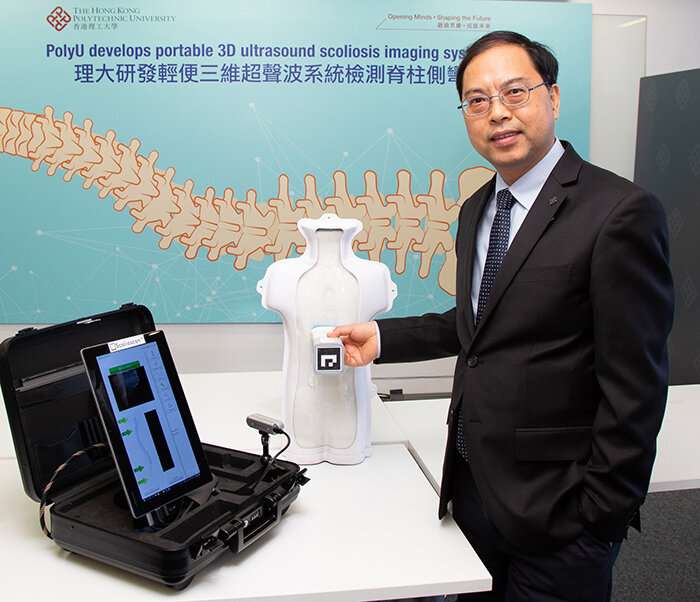Team develops palm-sized 3-D ultrasound imaging system for scoliosis mass screening

Scoliosis conditions can be detected early and monitored frequently, thanks to the portable imaging system developed by PolyU's experts in scoliosis research. The first-of-its-kind palm-sized 3-D ultrasound imaging system for radiation-free scoliosis assessment, named Scolioscan Air makes possible accurate, safe and cost-efficient mass screening.
Scoliosis is one of the most prevalent spinal diseases affecting adolescents. It is estimated that about 3 percent to 5 percent of adolescents in Hong Kong suffer from scoliosis, with increasing prevalence in recent years. A recent study in Guangzhou indicated that for girls aged 14 and 15, the prevalence is as high as 13.8 percent. About 15 percent of the adolescents with scoliosis would experience deteriorating conditions, and bracing or surgery would be required when spinal curves progress to moderate or severe status. Early detection of scoliosis conditions and regular check-up during the rapid growth of adolescent school children is thus crucial. At present, X-ray imaging is the clinical gold standard for scoliosis assessment, but radiation exposure may pose increased risk for cancer.
PolyU-developed scoliosis imaging technology
Ir Professor Zheng Yong-ping, Head of BME and Henry G. Leong Professor in Biomedical Engineering, who led the research, said Scolioscan Air is an advanced system based on the PolyU-developed 3-D ultrasound imaging technology under the trademark "Scolioscan" (weighed about 150 kg). Scolioscan was successfully commercialised into a clinical facility in 2016.
Being radiation-free and more cost-effective than prevailing X-ray imaging technologies, Scolioscan can facilitate mass screening and frequent follow-up monitoring. Clinical trials have proven the technology is reliable, with accuracy of curve measurement comparable to X-ray assessment. Moreover, it can obtain images in any posture, provide vertebra rotation and muscle-related information, and form a 3-D spinal model for the three-dimensional analysis of spinal deformity. Scolioscan can also be used to conduct prognosis and monitoring treatment outcomes for each scoliosis patient to establish a personalised treatment plan.
Palm-sized Scolioscan Air facilitates screening anywhere, anytime
The research team has recently developed a portable palm-sized Scolioscan Air weighing only 5 kg. "With this innovation, we can now bring the device and mass screening service to youngsters anywhere, anytime. It facilitates the implementation of school-based scoliosis screening to detect and treat spinal curvatures before they become severe enough to cause chronic pain or other health issues among adolescents," said Professor Zheng. "Moreover, when providing non-surgical treatment for scoliosis patients, healthcare personnel can use Scolioscan Air to conduct real-time assessment, so as to optimise the treatment outcome."
Scolioscan Air consists of three hardware components: (i) a palm-sized wireless ultrasound probe with an optical marker mounted at its bottom; (ii) a depth camera; and (iii) a laptop or tablet computer with dedicated software. The compact optical marker and depth camera replace the spatial sensor used in Scolioscan and thus help dramatically downsize the device.
In addition, the technology for 3-D ultrasound image reconstruction, visualisation and measurement, including a fully automatic curvature measurement method and 3-D spinal deformity analysis software, developed by the team earlier can also be applied to Scolioscan Air.
The newly developed optical 3-D spatial tracking method for Scolioscan Air achieves a high degree of accuracy comparable with Scolioscan. Moreover, the technological compatibility makes Scolioscan Air readily available for commercialisation for popular use. With dramatically reduced material cost, size and weight compared with other scanning systems, Scolioscan Air can be carried within a suitcase.




















